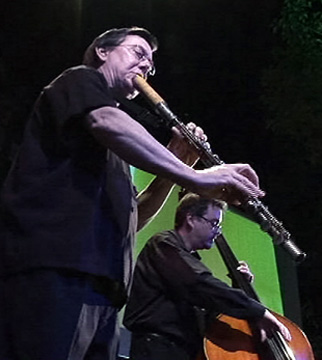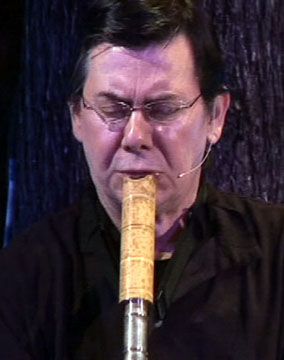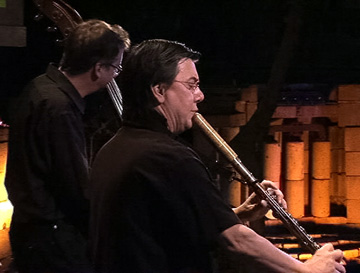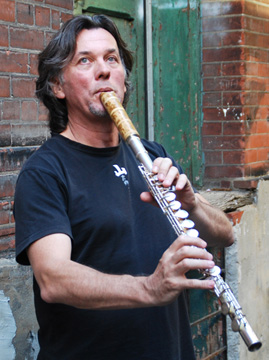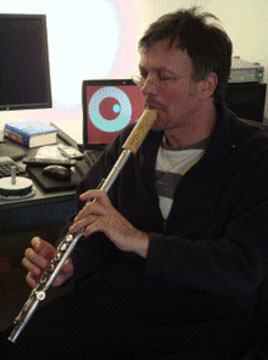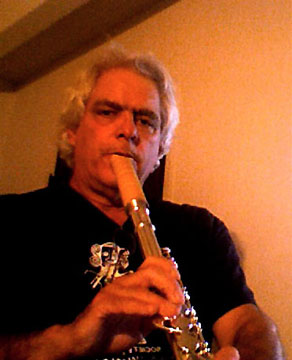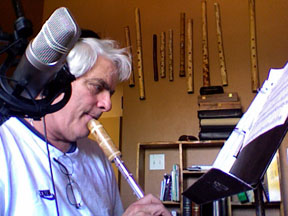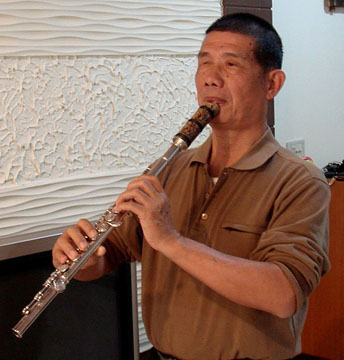
|
SHAKULUTE What People Say About The Shakulute
Page 2 |
|
"Monty’s shakulute c reation has opened up the door for so many new sonic possibilities in my music. I use many styles blending east and west, and feature flutes from around the world. Until recently, when including the shakuhachi, I have had to limit the key centers, modes, and the use of complex chromatic passages. The shakulute has removed all those limitations. " I use an alto flute version, and the lowest octave is amazing, with a fat rich tone all the way down. It is a breeze to play full chromatic passages and yet include the nuances of the traditional shakuhachi at any point, on any note. "I wrote a piece entitled “The River” to celebrate this wonderful addition to my flute arsenal. You can hear a taste of this tune under The Listen tab onmy web site. "You can watch video and hear my live performance on this instrument on The Artery’s website. "Thank you, Monty, for your innovation and fine craftsmanship!" Bob Chadwick Bob Chadwick is a professional flutist who performs jazz, classical and world music. In addition to playing jazz clubs or events, Bob has performed with national touring productions of Flower Drum Song, Lord of the Rings, The Lion King, and Miss Saigon. Flutes include Bass, Contrabass, Alto Shakulute, Shakuhachi, Bansuri, Dizi, pans, Quena, & Whistles. |
"The shakulute is the invention of Monty Levenson, a shakuhachi maker based in California. In a sentence, it is a shakuhachi head joint designed and calibrated to be attached and played on a standard concert flute body and foot joint. Basic information is well documented on his site. "I am a freelance concert flutist, and a shakuhachi player. Not infrequently I work as a studio multiple flutist. The promise of the shakulute is that is combines the rich timbre and pitch nuance of the shakuhachi with the chromaticism, pitch dexterity and range of the concert flute. that it would be an excellent problem solver in the studio. In my experience, commercial studio composers are notoriously unaware of any of the basic instrumental features of unusual flutes like the shakuhachi. I have been playing the shakuhachi since the early 1990s, and have had numerous instances of composers either writing music too complex for the shakuhachi (in once instance a chromatic piece in B-flat minor which transposes into A major and E major at various points), or music which is too simplistic for the shakuhachi (simple melodic diatonic music written with no understanding of meri technique or techniques of shading the holes, and hence surprise at the pitch, timbre and dynamic envelope nuances that result). The shakulute makes sight reading such sessions possible. It gives the composer the best of the two (or three!) worlds that they want. "But the shakulute should be understood in its own right. If the whole is greater than the sum of its parts, then the shakulute is more than the sum of the attributes of the flute and shakuhachi. The resistances in the shakulute are not like those of either precedents. I have been playing it long enough that I am beginning to understand these. It is especially so when I do extended technique playing. When you are playing multiphonics, circular breathing, searching for new timbres, you push the instrument past what the instrument is conventionally designed to do. The instrument’s limits and excesses become more apparent. I do a lot of extended technique improvisation on the shakulute, so I am always in touch with this. I get more out of the shakulute when I don’t think of it as the best of two worlds. Rather, I prefer to experience it is a novel and complex world of embouchure and finger control meshing, and of complex standing wave phenomenon modulated by both resonant and vented resistances which I can’t always track. Of course after some practice, the gestalt of the shakulute becomes clear. You can feel what is happening in a physical gesture and you can follow it. And it sure isn’t a flute or shakuhachi! "Playing Honkyoku on the shakulute is a telling experience. As one would expect you have make all kinds of adjustments to make it sound like a bamboo flute resulting from the keys, fingerings differences and how you hold the flute. But once you have solved those difficulties ( and you have an room acoustic which helps absorb the key closure sounds), you can sound like a bamboo instrument. It is a telling experience because it demonstrates that it is less the instrument material and more the design and performance practice that makes the music. (But you have to love bamboo!) "I am going in another direction with the shakulute next. On Sept. 20 (2009) at Beijing University, I’ll be giving a solo recital called “The Multiple Flutist.” On that program, the shakulute is paired with J.S.Bach. The e minor sonata lends itself to such a novel commentary as I think the shakulute will provide. If I take my experience of extreme limits, and restrain and compress the parameter values, then it is possible to play Baroque music. So, German Baroque played by a New York player on a California hybrid Japanese flute... Where should the plane land? Beijing is a probably as good a triangulated landing site as any!" Bruce Gremo
|
|
|
"As a pianist and composer, one is always surprised at how life experience translates or reflects into music. My interest in wind instruments and shakuhachi has brought such an expansion to my work at the piano and into composition. "But rarely has an instrument like my new ALTO SHAKLUTE inspired a new personal paradigm. Breathing into the SHAKLUTE immediately caused an indescribable awareness of possibility. I have begun creating compositions inspired by this incredible hybrid flute. Many times while playing SHAKLUTE I will get new insights and then go to the keyboard and jot down ideas that showcase the SHAKLUTE's immense diversity. "I have been playing it for over a month now and am quite comfortable with it. in fact, I am eager to acquire a headjoint for my C flute. My aresenal of regular shakuhachi had been suffering a bit of neglect, but I am beginning to go back and forth. I use the SHAKLUTE on all my gigs and am continually blown away (pun intended). On jazz gigs the ALTO SHAKLUTE is a welcomed guest. " This is a great achievement, Monty. Thanks for the great work." Bruce Stoller |
"I discovered Monty's web site on the Taiwan Shakuhachi Blog. I shared this web site with my daughter who ordered a Shakuhachi headjoint for me. I installed the headjoint and I immediately fell in love with the new spectrum of notes. I wish I would have found out about his site earlier. "What a great invention this is! It brings together Western and Eastern music unlike any other kind of instrument. The high notes are so sharp and bright like a Western flute. The lower notes have a deep and rich sound common in Eastern instruments. Arwingo Yu |
|
What People Say About the Shakulute |
|||||
Page 2 |
|||||
